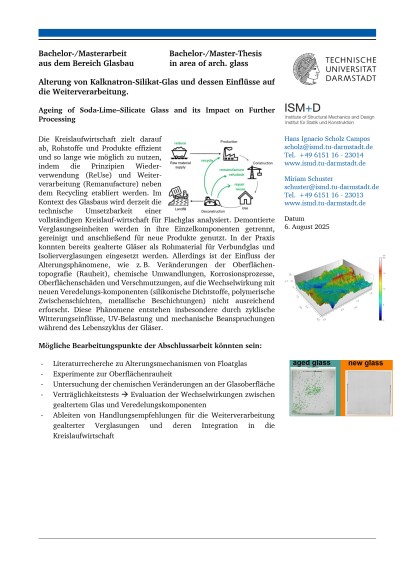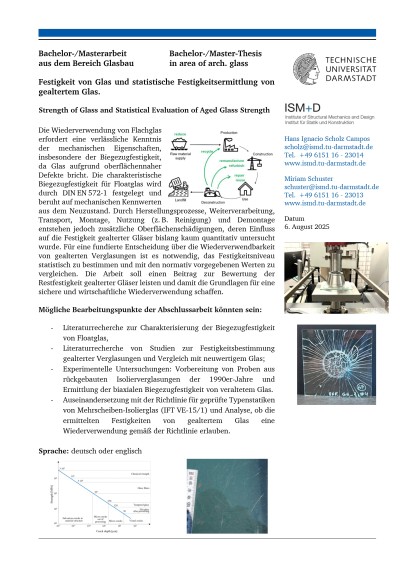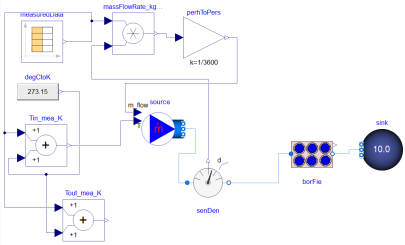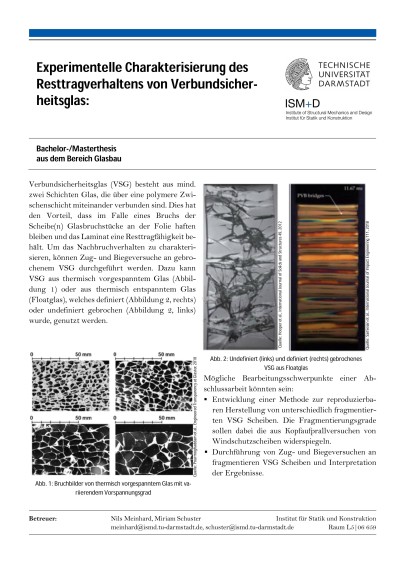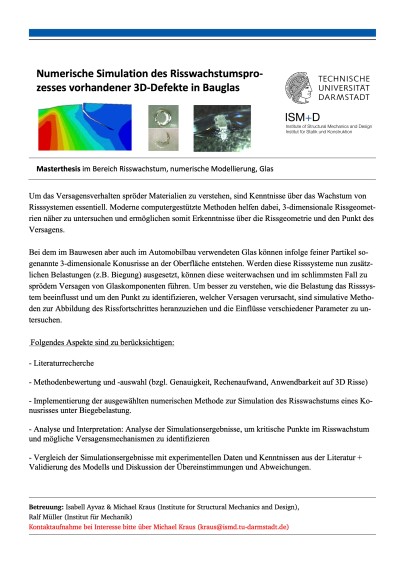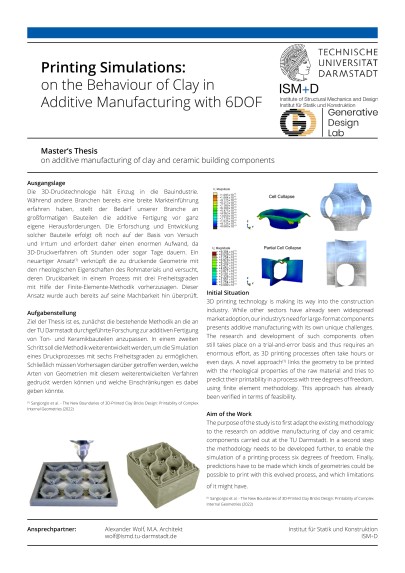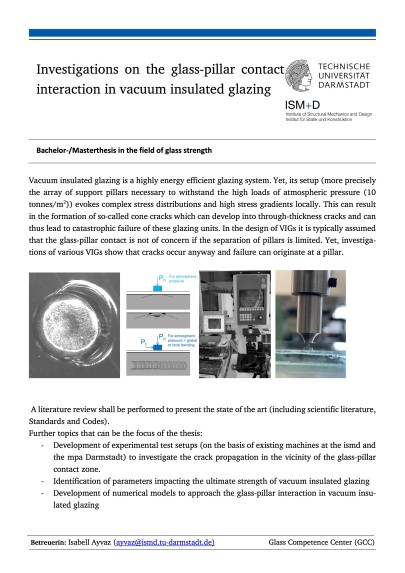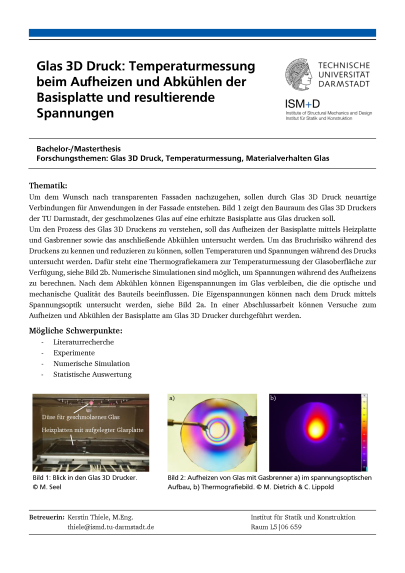Supervisor: Prof. Dr.-Ing. Clemens Hübler
Lebenszyklusanalyse in den frühen Tragwerkentwurfsphasen
Lebenszyklusanalyse in den frühen Tragwerkentwurfsphasen für verschiedene Konstruktionsprinzipien und Entwicklung eines Designtools
2025/09/15
Supervisor: Bernadette Lang-Eurisch , M.Sc.
Ageing of Soda-Lime–Silicate Glass and its Impact on Further Processing
Alterung von Kalknatron-Silikat-Glas und dessen Einflüsse auf die Weiterverarbeitung
2025/08/06
Context
A circular-economy approach seeks to extend the service life of resources and products by moving beyond traditional recycling towards reuse and remanufacturing. In architectural glass construction, this means dismantling glazing units, separating their components, cleaning them and upgrading them to new products. Recovered aged flat glass has already been used as a feedstock for laminated glass and insulating glazing units. However, the interaction of aged glass surfaces with new processing components — such as silicone sealants, polymer interlayers and metal coatings — has not been thoroughly investigated. Ageing phenomena such as changes in surface topography, chemical alterations, corrosion, surface damage and contamination occur due to exposure to weather cycles, UV radiation and mechanical loading throughout the glass’s service life. These changes may affect adhesion, durability and overall performance of new products manufactured from reclaimed glass. The aim of this thesis is to analyse these ageing mechanisms systematically and to assess their influence on the remanufacturing processes for aged float glass.
Possible topics for the thesis could include:
- Literature research on aging mechanisms of float glass
- Experiments on surface roughness
- Investigation of chemical changes on the glass surface
- Compatibility tests Evaluation of interactions between aged glass and finishing components
- Derivation of recommendations for action for the further processing of aged glazing and its integration into the circular economy
Languages: english or german
Supervisors: Hans Ignacio Scholz Campos,, M.Sc., Dr.-Ing. Miriam Schuster
Strength of Glass and Statistical Evaluation of Aged Glass Strength
Festigkeit von Glas und statistische Festigkeitsermittlung von gealtertem Glas
2025/08/06
Context
Reusing flat glass requires reliable knowledge of its mechanical properties, particularly bending tensile strength, since glass fails at surface defects. The characteristic bending tensile strength of float glass is specified in DIN EN 572‑1 based on tests on new glass. Additional surface damage arising from manufacturing, processing, transport, installation, use (e.g., cleaning) and dismantling can significantly reduce the residual strength of aged glass. There is a lack of quantitative data on how ageing affects the strength distribution of reclaimed glazing. To make sound decisions on the structural reuse of aged glass, it is essential to determine its strength statistically and compare it with normative values. This thesis aims to contribute to the assessment of residual strength in aged glass panes, thereby providing a scientific basis for safe and economical reuse.
Possible topics for the thesis could include:
– Literature research on the characterization of the flexural strength of float glass,
- Literature research on studies to determine the strength of aged glazing and comparison with new glass,
- Experimental investigations: preparation of samples from dismantled insulating glazing from the 1990s and determination of the biaxial flexural strength of aged glass,
- Examination of the guideline for tested type statics of multi-pane insulating glass (IFT VE-15/1) and analysis of whether the determined strengths of aged glass allow reuse in accordance with the guideline.
Languages: english or german
Supervisors: Hans Ignacio Scholz Campos,, M.Sc., Dr.-Ing. Miriam Schuster
2025/04/25
The urgency of developing more sustainable building materials and methods is obvious. Thus, novel building materials such as paper are gaining relevance. Until now, paper in buildings has been used primarily in furniture construction or for temporary structures. The insights resulting from these applications and additional research show that paper also has considerable potential as a building material for permanent load-bearing structures.
For a holistic consideration of paper as a building material, joining techniques must be examined, among other things. Often, glued papers cannot be recycled after their lifespan. For this reason, mechanical fasteners for paper construction should be considered. The goal of this work is to investigate shear-bearing connections of mechanical fasteners in paper both experimentally and numerically/analytically.
Supervisor: Henriette Hoffmann, M.Eng.
2025/01/27
Supervisor: Niklas Dierksen, M.Sc.
Cost-effective and sustainable construction is a hot topic due to the extremely tight housing market and the need to make future construction environmentally friendly. Tiny houses made of paper offer a sustainable and innovative alternative to conventional building materials. Paper as a building material is lightweight, recyclable and has a significantly lower environmental impact, as it comes from renewable resources and can be easily recycled at the end of its life cycle. These properties make it particularly attractive for the construction of tiny houses, which already aim for minimalist and environmentally friendly lifestyles. A life cycle assessment (LCA) is therefore essential to fully evaluate the environmental benefits of paper tiny houses. With an LCA, the carbon footprint as well as other environmental factors such as energy consumption, water consumption and waste generation can be quantified over the entire life cycle – from material extraction to disposal. This allows well-founded decisions to be made that contribute to the further optimization and acceptance of this sustainable construction method.
Supervisors: Naomi Bosse, M.Sc., Inés Burdiles , M.Sc.
Vergleichsplattform für Erdwärmesondenmodelle
Benchmark toolbox for borehole heat exchanger models
2024/11/28
Heat pumps have been identified as key technologies for decarbonizing the energy system. Heat pumps coupled to borehole heat exchangers are especially efficient.
In this thesis, a benchmark toolbox is developed to support the comparability of borehole heat exchanger models.
Supervisor: Xenia Kirschstein , M.Sc.
Laminated safety glass (VSG) consists of at least two layers of glass bonded together by a polymeric interlayer. This has the advantage that, in the event of a breakage, glass fragments adhere to the interlayer, and the laminate retains residual load-bearing capacity. To characterize the post-breakage behavior, tensile and bending tests can be performed on fractured VSG. For this purpose, VSG made of thermally tempered glass or annealed glass (float glass), which has been broken in either a defined or undefined manner, can be used.
Possible focus areas for a thesis could include:
- Development of a method for the reproducible production of VSG panes with varying degrees of fragmentation. The fragmentation levels should reflect those observed in head impact tests on windshields.
- Conducting tensile and bending tests on fragmented VSG panes and interpreting the results.
Supervisors: Nils Meinhard,, M.Sc., Dr.-Ing. Miriam Schuster
Active Learning and Conditional Autoencoders
Innovative Approaches for Navigating Nonlinear Design Spaces of Multi-Story Structural Systems
2024/09/10
This master thesis develops AI-driven methods for design space exploration of multi-story frame structures, focusing on geometrically and material nonlinear behavior. The research implements active learning strategies and a conditional autoencoder tailored to structural engineering applications. Motivated by the need to efficiently navigate complex design spaces, the study considers nonlinearities, costs, and utilization rates in multi-story structures. By combining active learning for strategic sampling with a conditional autoencoder for dimensionality reduction and generative design, the thesis aims to create an intelligent framework for optimizing structural configurations. The findings are expected to provide insights into AI-driven design exploration in structural engineering, potentially transforming approaches to complex, nonlinear structural problems.
Supervisor: Prof. Dr.-Ing. Michael Kraus
DigitalCeramicRoofTiles: an approach on preserving heritage buildings through additive manufacturing
2024/08/30
Hessenpark is an open-air museum dedicated to historical village life in our federal state. In addition to the preservation of historical objects of daily use and the cultivation of traditional craftsmanship, aspects of monument preservation also play a major role in its museum concept. So far, over 100 historic buildings worthy of protection have been saved from total demolition by relocating them to the museum grounds. However, the preservation of these buildings is constantly facing new challenges, whose solutions through AM are to be investigated.
The aim of this thesis is to investigate the extent to which 3D-printed tiles could be used to restore damaged roofs. Often, historical building elements are no longer available on the market. 3D scanning and modeling based on existing examples offers the potential to “reprint” such. In addition to the theoretical part, which describes the basics and working methods of heritage conservation and additive manufacturing, a practical investigation using the example of historical roof tiles is also to be carried out and evaluated as part of this work.
Supervisor: Dr.-Ing. Architekt Alexander Wolf
Numerische Simulation des Risswachstumsprozesses vorhandener 3D-Defekte in Bauglas
Numerical simulation of the crack evolution of 3 dimensional defects in glass
2024/08/05
Software-Implementierung eines bruchmechanischen Modells zur Analyse der Parametersensitivität bzgl. der Festigkeitsminderung spröder Materialien
Software implementation of a fracture mechanics model to analyze the parameter sensitivity regarding the strength reduction of brittle materials
2024/08/05
Vacuum insulating glasses (VIGs) are an innovative window technology with the potential to revolutionize energy-efficient buildings. Windows and transparent facade elements are the main sources of heat loss and CO2 emissions in buildings.VIGs consist of glass panes with a vacuum gap that minimizes thermal effects and improves the energy balance of building envelopes. Small spacers in the va- cuumed inter-pane space ensure stability over decades and significantly influence the behavior of VIGs. Investigation of this influence and the development of standards for the use of VIGs are crucial for the introduction of energy-optimized window and facade systems in Germany and Europe. VIGs could thus make a significant contribution to sustainability in construction.
Supervisor: Isabell Ayvaz, M.Sc.
3D printing technology is making its way into the construction industry. While other sectors have already seen widespread market adoption, our industry‘s need for large-format components presents additive manufacturing with its own unique challenges. The research and development of such components often still takes place on a trial-and-error basis and thus requires an enormous effort, as 3D printing processes often take hours or even days. A novel approach(1) links the geometry to be printed with the rheological properties of the raw material and tries to predict their printability in a process with tree degrees of freedom, using finite element methodology. This approach has already been verified in terms of feasibility.
The purpose of the study is to first adapt the existing methodology to the research on additive manufacturing of clay and ceramic components carried out at the TU Darmstadt. In a second step the methodology needs to be developed further, to enable the simulation of a printing-process six degrees of freedom. Finally, predictions have to be made which kinds of geometries could be possible to print with this evolved process, and which limitations of it might have
Supervisor: Dr.-Ing. Architekt Alexander Wolf
The construction sector is, due to the sheer size of buildings as its final roducts, one of the largest emmiters of waste in the European Union. For much of this, the demolition of buildings is to be held accountable, but also during production of building components a significant quantity of surpluses and waste appears. While novel approaches attempt to recylcle shredded ceramics into new bricks, other leftovers still remain unused. The purpose of the study is to first explore the different kinds of wastes and surpluses, that occur during brick production. Also, their yearly occurence needs to be quantified. In a second step, different strategies need to be formulated to up-, down- or recycle these leftovers. Further, depending on the formulated strategies, experiments have to be carried out als a proof-of-concept for some of the strategies. Last, predictions have to be calculated on how much economic and environmental impact the up-, re- or downcycling of the production leftovers could have.
Supervisor: Dr.-Ing. Architekt Alexander Wolf
Ein Werkzeug zur Prognose von Schneebrettlawinen
A tool for the prediction of slab avalanches
2024/04/17
Winter sports enthusiasts and mountain infrastructure are constantly threatened by the danger of snow avalanches. But how do these avalanches actually form? Similar to the failure of constructions, avalanches can be traced back to a weakness in the snowpack. However, thanks to modern fracture mechanics and solid material knowledge, we are now facing new possibilities for predicting avalanches more accurately.
Research goal
The aim is to create a practical tool that allows users to immediately assess the initiation and propagation tendencies of snow avalanches by inputting snowpack data.
Supervisors: Valentin Adam, M.Sc., Dr.-Ing. Philipp Rosendahl
Untersuchung des Einflusses von Fassadenbegrünung auf das thermische und hygrische Verhalten von Wandkonstruktionen
Influence of façade greening on the thermal and hygric behaviour of wall constructions
2024/02/02
Vacuum insulating glasses (VIGs) are an innovative window technology with the potential to revolutionize energy-efficient buildings. Windows and transparent facade elements are the main sources of heat loss and CO2 emissions in buildings.VIGs consist of glass panes with a vacuum gap that minimizes thermal effects and improves the energy balance of building envelopes. Small spacers in the va- cuumed inter-pane space ensure stability over decades and significantly influence the behavior of VIGs. Investigation of this influence and the development of standards for the use of VIGs are crucial for the introduction of energy-optimized window and facade systems in Germany and Europe. VIGs could thus make a significant contribution to sustainability in construction.
Supervisor: Dr. Nadja Bishara
BIM to BEM: Building Energy Analysis based on Building Information Modeling
BIM zu BEM: Gebäudeenergieanalyse basierend auf Gebäudedatenmodellierung
2024/01/29
Supervisors: Dr. Nadja Bishara , Yang Xue , M.Sc.
2023/12/07
Supervisors: Joscha Reber , M.Sc., Dr. Nadja Bishara
2023/09/27
Glass is a ubiquitous material in modern engineering applications, prized for its transparency, strength, and versatility. However, glass is inherently brittle, and its susceptibility to crack initiation and propagation poses significant challenges in structural and safety-critical contexts. Understanding how cracks propagate in indented glass specimens under subsequent loading is therefore critical for enhancing the safety and reliability of glass- based structures and products.
The outcomes of this thesis are expected to contribute to the knowledge base on glass fracture mechanics and safety assessment. Moreover, the findings may have practical implications for improving the design and perfor- mance of glass components in engineering applications, such as architectural glazing, automotive windshields, and electronic displays.
Supervisor: Isabell Ayvaz, M.Sc.
While the glass panes in conventional lattice shells are typically used only as infill elements, activating the full load-bearing potential of glass can contribute significantly to reducing the material and energy resources of substructures for glass facades.
A current research project is investigating the integration of local and linear connection structures in glass supporting structures, which should help to better exploit the structural potential of the glass panes used and thus reduce the steel consumption in substructures to a necessary minimum. This should ultimately enable the construction of transparent glass structures with a wide variety of shapes and applications.
Supervisor: Isabell Ayvaz, M.Sc.
Vacuum insulated glazing is a highly energy efficient glazing system. Yet, its setup (more precisely the array of support pillars necessary to withstand the high loads of atmospheric pressure (10 tonnes/m2)) evokes complex stress distributions and high stress gradients locally. This can result in the formation of so-called cone cracks which can develop into through-thickness cracks and can thus lead to catastrophic failure of these glazing units. In the design of VIGs it is typically assumed that the glass-pillar contact is not of concern if the separation of pillars is limited. Yet, investiga- tions of various VIGs show that cracks occur anyway and failure can originate at a pillar.
Supervisor: Isabell Ayvaz, M.Sc.
Vacuum insulating glasses (VIGs) are an innovative window technology with the potential to revolutionize energy-efficient buildings. Windows and transparent facade elements are the main sources of heat loss and CO2 emissions in buildings.VIGs consist of glass panes with a vacuum gap that minimizes thermal effects and improves the energy balance of building envelopes. Small spacers in the va- cuumed inter-pane space ensure stability over decades and significantly influence the behavior of VIGs. Investigation of this influence and the development of standards for the use of VIGs are crucial for the introduction of energy-optimized window and facade systems in Germany and Europe. VIGs could thus make a significant contribution to sustainability in construction.
Supervisor: Isabell Ayvaz, M.Sc.
Optimierungspotenzial in der Wärmeversorgung eines Wohnquartiers mit Alt- und Neubauten
Optimization potential in the heat supply of a residential district with old and new buildings
2023/09/27
Supervisors: Xenia Kirschstein , M.Sc., Joscha Reber , M.Sc.
The thermal behavior of building envelopes is a crucial factor that significantly impacts the overall energy consumption of buildings and therefore plays a pivotal role in achieving the ambitious climate goals set for 2050.By incorporating phase change materials (PCM) into building design, the energy storage capacity of buildings can be significantly enhanced. This improvement in energy storage capacity can offer greater energy flexibility, thus creating more opportunities for the integration of volatile renewable energy sources
Supervisors: Dr. Nadja Bishara , Yang Xue , M.Sc.
Supervisor: Maximilian Rupp, M.Sc.
2022/05/02
Supervisors: Jonas Muth , M.Sc., Dr.-Ing. Miriam Schuster
2022/04/19
The aim of a current research project is to predict complex crack propagation during the glass breakage process as well as the resulting fragment geometry and size. To this end, ISM+D is creating a database from experimental studies in which glasses with different thermal toughness levels are broken in a targeted manner. The wave propagation in the glass body resulting from the impact is recorded with special sensors. The fracture pattern is analyzed by means of digital image processing.
Possible topics for a thesis (Bachelor or Master):
- Numerical characterization of fracture morphologies in thermally toughened glasses.
- Stochastic modeling of fracture morphologies in thermally toughened glasses
Supervisor: Dr.-Ing. Miriam Schuster
To address the desire for transparent facades, glass 3D printing will be used to create novel joints for facade applications. Figure 1 shows the construction chamber of the glass 3D printer at the TU Darmstadt, which is to print molten glass onto a heated base plate made of glass.
To understand the process of glass 3D printing, the heating of the base plate using a hot plate and gas burner and the subsequent cooling will be studied. In order to know and reduce the risk of breakage during printing, temperatures and stresses during printing will be studied. For this purpose, a thermographic camera is available to measure the temperature of the glass surface, see Fig. 2b. Numerical simulations are possible to calculate stresses during heating. After cooling, residual stresses may remain in the glass, affecting the optical and mechanical quality of the component. The residual stresses can be studied after printing using stress optics, see Fig. 2a. Experiments on heating and cooling the base plate on the glass 3D printer can be carried out in a thesis.
Supervisor: Kerstin Thiele , M.Eng.
Supervisors: Dr.-Ing. Miriam Schuster , Kerstin Thiele , M.Eng.
Breakage behavior of automobile windshields in pedestrian protection
External master thesis at Volkswagen in the field of strength of glasses
2022/01/25
Vehicle safety has the task of developing vehicles in such a way that accidents are avoided or the consequences of accidents are reduced as much as possible. In the field of pedestrian protection, so-called impactors are used to represent parts of the human body (head, hip and leg) and to assess the risk of injury in the event of a collision with the vehicle. The criteria and limits for assessing impactor load cases are defined and continuously developed by legislation (UN R 127) and consumer protection organizations (Euro NCAP). For example, the area of the windshield is newly included in the legal impact area and extended beyond the previous level for the Euro NCAP consumer protection test.
Further information, application requirements and documents to be submitted, etc. can be found here
Supervisor: Dr.-Ing. Miriam Schuster
Laminated glass consists of at least two sheets of glass joined by a polymer interlayer. In the event of glass breakage, a residual load-bearing behavior occurs in which tensile stresses caused by bending are removed via the polymer interlayer. Numerical mapping of the material behavior of the interlayer in the case of large deformations, as occurs in the case of failure of one or more glass sheets, is currently not possible. The material behavior in this case depends on temperature and loading duration as well as on the magnitude of the load, so that nonlinear viscoelastic material models are necessary.
Supervisors: Dr.-Ing. Miriam Schuster , Kerstin Thiele , M.Eng.
Vakuumisolierglas – Technologie für eine energieoptimierte Gebäudehülle
Vacuum insulated glazing – A technology for an energetically optimized transparent building envelope
2022/01/13
Vacuum insulating glazing (VIG) units are an innovative window technology that has the potential to revolutionize energy-efficient buildings. Windows and transparent façade elements are respon- sible for a large proportion of heat loss in buildings and therefore a large carbon footprint. A vac- uum insulation glazing consists of two or more glass panes between which a vacuum gap is created. This allows thermal effects to be minimized, thus optimizing the energy balance of the transparent areas of building envelopes. To ensure that the individual panes of the VIG can withstand the high stress of atmospheric pressure over several decades, small spacers are inserted into the vacuum gap as shown in the figure below. These are very small and, in addition to the edge seal which hermetically seals the VIG, have a decisive influence on the mechanical and thermomechanical behavior of VIGs. It is now exciting to investigate this influence and to develop implications for the normatively regulated use of the innovative glazing units in order to make a decisive contribution to the establishment of energy-optimized window and facade systems in Germany and Europe.
Supervisors: Isabell Ayvaz, M.Sc., Franz Paschke, M.Sc.
Entwicklung einer Methode zur Qualitätskontrolle bei Vakuumisoliergläsern
Development of a method for quality control of vacuum insulated glazing
2022/01/09
Supervisors: Dr.-Ing. Henrik Riedel, Isabell Ayvaz, M.Sc.
Bruchzähigkeit bei steifen Klebern: Auslegung und Dimensionierung von Experimenten an Glaskörpern
Fracture toughness in stiff adhesives: Design and dimensioning of experiments on glass specimen
2021/12/21
The innovative and smart glass product eyrise®, based on liquid-crystal technology, can change its transparence and color within seconds. The edges of the glass panes are sealed with a stiff polymeric adhesive. The employed adhesive layers are thin and thereby shear resistant while simultaneously providing a high adhesion between the two adherends. Due to the geometry of the adhesive layer and the requirements of later numerical investigations, two experimental setups are to be dimensioned. By those means, the fracture toughness for both crack opening mode I and II are to be determined while the similar strength of adhesive and adherends have to be considered.
Supervisor: Dr.-Ing. Florian Rheinschmidt
Folienkissen aus Dünnglas
Thin glass foil cusions
2021/12/09
Supervisor: Dr.-Ing. Timon Peters
Numerische Simulation der thermisch induzierten Spannungen von Fassadenverglasungen
Numerical simulation of the thermally induced stresses of facade glazing
2021/03/29
Supervisor: Gregor Schwind , M.Sc.
Numerische Untersuchungen zum thermisch induzierten Glasbruch beim Doppelringbiegeversuch bei hohen Temperaturen
Numerical investigations on thermally induced glass fracture in the coaxial bending test at high temperatures
2021/03/29
Supervisor: Gregor Schwind , M.Sc.
Institut für Statik und Konstruktion

Masterthesen
Masterthesen
The content of this page is only available in German.
Please go to German version of this page




